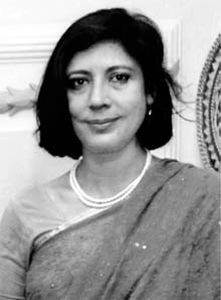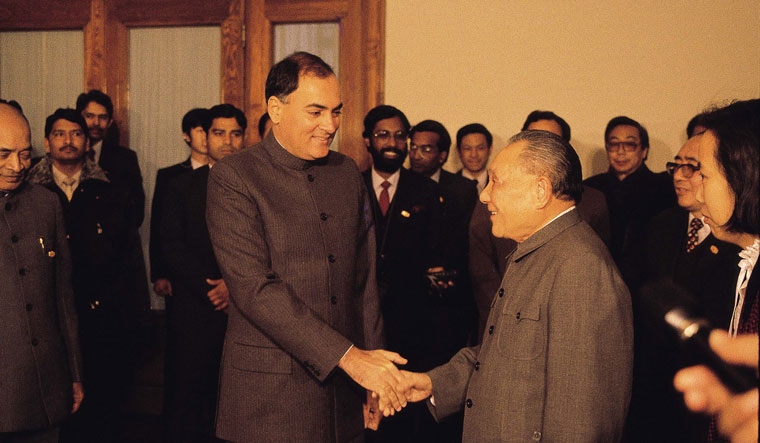I am young and I, too, have a dream”. These lines are from Rajiv Gandhi’s speech to the joint houses of the United States Congress in 1985. His dream was tragically cut short, but not before he had made an impressive impact on the international stage. Not only was he the scion of India’s then-premier political family, but he was also a handsome, personable young man who guaranteed the stability and continuity of India’s foreign and domestic policy.
Rajiv’s term as prime minister was perhaps the last time India could claim to be the preeminent South Asian power—a country whose help was sought by other neighbours, even those not part of its traditional sphere of influence in south Asia. It was a time when China was still in the early stages of its rise to power and when the world was still a bipolar contest between the Soviet Union and America.
Rajiv Gandhi was quoted in The Times of India (November 12, 1984), promising continuity in India’s foreign policy. He said, “Jawaharlal Nehru bequeathed to us a foreign policy which Indira Gandhi so creatively enriched. I shall carry it forward.” He did continue India’s special partnership with the Soviet Union, but also sought to reset relations with the US and China.
He visited the Soviet Union from May 21 to May 26, 1985—his first official visit to any country. It was at the banquet with Mikhail Gorbachev that he stated his desire to see south Asia free of external influence—a hint at India’s opposition to the Soviet presence in Afghanistan. The strength of the partnership was reinforced with major agreements signed during his visit, including a credit line of 01,000 crore and an agreement to cooperate in the fields of science and technology. Gorbachev’s faith in Rajiv was reasserted when he was invited to Moscow on his return from a US visit to brief the former of his impressions of US president Ronald Reagan—whom the Russian president was still to meet. Gorbachev visited India in May 1986, resulting in the Delhi Declaration that further guaranteed India credit for enhancing its technology and energy sectors, described as a “qualitatively new stage”. The declaration called for a new world order and also outlined the principles of a nuclear-free world, an issue very close to Rajiv’s heart and one that he highlighted in his address at the United Nations.
With western powers, including the US, Rajiv cultivated an independent, yet open and constructive, relationship. He visited important western capitals and signed several agreements that included again, his emphasis on scientific and technological cooperation. This desire for advanced technology and modernisation was key to Rajiv’s dreams for India and was emphasised in his foreign policy initiatives.
Also read
- A Kindred Spirit recalls Rajiv Gandhi memories
- Rajiv Gandhi: The caring and cordial democrat
- Rajiv Gandhi opened the doors for 1991 reforms: Montek Singh Ahluwalia
- Politicians of my generation were inspired by Rajiv Gandhi: Bhupesh Baghel
- Rajiv knew a divided Sri Lanka would create problems for India: Mani Shankar Aiyar
- Political naivety overshadowed much of Rajiv Gandhi’s positive work: Rasheed Kidwai
- How Rajiv Gandhi’s peace deals materialised: Vappala Balachandran
He was keen to reset India’s relationship with the US and made two highly successful, and publicised visits to the US in 1985 and 1987. He pushed for and extended the terms of an MoU signed for the transfer of technology. During his speech after their meeting in 1987, Reagan stressed the importance that Rajiv held for gradual nuclear disarmament. They also signed an MoU for cooperation in the development of the defence sector. A CIA report from August 1985 (The Economic Times; August 4, 2017) noted that three signals emerged from Rajiv’s foreign visits: “First, his apparent willingness to give a fair hearing to other points of view strongly suggest that he is motivated to try to cut through emotionally charged issues, to get into problem-solving. This has, in our view, been played out in his ‘step-by-step’ approach to improving relations with the US and Pakistan, and to resolving the Tamil-Sinhalese conflict in Sri Lanka.”
The report also highlighted Rajiv’s keen interest in western technology and his desire for the technological modernisation of India. Rajiv was indeed the first prime minister to stress that India needed to build its technological sector by engaging with the western world. He visited high-tech facilities in the US and France. It was due to his interest and push that India’s fledgeling information technology industry emerged and put Indian science and engineering on the world map, turning India into the software giant and Bengaluru into an international city. This was perhaps his greatest long-term gift to the country and his chief legacy.
However, it was in South Asia that we saw him emerge as a confident leader of a strong nation-state. This was the last time that India would send troops to another country when requested for help. Here, of course, we refer to the actions that India took concerning Seychelles and the Maldives. During Operation Cactus, India sent troops to the Maldives to thwart a coup against president Maumoon Abdul Gayoom in 1988. Similarly, the Indian Navy was sent to Seychelles (Operation Flowers are Blooming) to avert a coup against the government of president France-Albert Rene in 1986. This not only showed India’s own capability in the Indian Ocean region but proved that its forces were ready to help in the maintenance of democratically-elected governments in the region.
Rajiv’s Sri Lanka policy, too, was meant to showcase Indian reach. The agreement that he secured with Sri Lankan president J.R. Jayewardene—the accord of 1988—safeguarded Indian interests, and secured for the Tamil population of Jaffna, some breathing space. Unfortunately, the participation of Indian forces in Sri Lanka to help maintain the peace agreement, alienated the Liberation Tigers of Tamil Eelam, leading to the terrorist attack that took Rajiv’s life in 1991, denying India a future with a maturing, democratic and internationalist leader at the helm.
Relations with India’s traditional adversary, Pakistan, too, improved under Rajiv’s leadership. The victory of Benazir Bhutto in Pakistan and Rajiv in India— both young, both cosmopolitan and scions of political dynasties—did bring the hope of a lasting peace and a new reset. But forces stronger than them were to deny both a future.
However, it was in the domain of Sino-Indian relations that Rajiv made dramatic gains. His visit to China in 1988, the first by a prime minister since Nehru’s visit to China in 1955, laid the framework for dialogue and the mutual opening of trade and cultural contacts. We are still reaping the benefits of this groundwork laid by Rajiv in his meetings with Chinese leader Deng Xiaoping and prime minister Li Peng. It was on Deng’s suggestion that Rajiv accepted the formula, setting aside the boundary dispute and working on improving bilateral ties by cooperating in other sectors. India’s China policy even today is based on this 1988 framework and had gone a long way in maintaining cordial relations between the two countries, till the Doklam crisis of 2020.
Rajiv Gandhi’s overall foreign policy matrix reflected his priorities: Bringing a technological revolution to India; encouraging a home-grown technology sector; strengthening India’s security and primacy in South Asia.
Ravni Thakur is a professor at the Department of East Asian Studies, University of Delhi.




